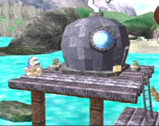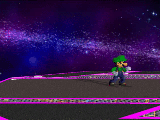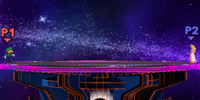Wavedash: Difference between revisions
| Line 8: | Line 8: | ||
lol m2k | lol m2k | ||
lol m2k | |||
==Strategies== | ==Strategies== | ||
Revision as of 08:36, May 21, 2015
A wavedash is a technique/physics engine exploit in Super Smash Bros. Melee that is performed by air dodging diagonally into the ground, causing the character to slide a short distance. While it is uncommon in casual play, high-level play of Melee effectively requires proper use of the technique; the Melee community sees wavedashing as an advanced technique superior to dashing because it allows players to perform any ground action while moving horizontally on the ground. Use of the technique is especially important for the metagame of characters with poor traction, such as Luigi, Mewtwo, and the Ice Climbers, and almost every other character requires some use of wavedashing for positioning and maneuvering, particularly in combos and mindgames.
Contrary to popular belief, wavedashing is not strictly a glitch; it is more accurately a corner case of Melee's physics engine. In an interview, Masahiro Sakurai acknowledged that the dev team was aware of wavedashing during development. When air dodging diagonally to the ground, all of the momentum of the airdodge is transferred into horizontal (ground) movement, since the character can no longer fall. Additionally, performing a wavedash causes the game to recognize the character as landing from the helpless state due to air dodges causing the state. Thus, the game is not recognizing wavedashing as a specific "technique" (such as an attack or movement) but as if the character simply landed and stood still; the sliding effect is due to the "slipperiness" inherent in the game's engine.
lol m2k
lol m2k
Strategies
Approach
For some characters, wavedashing is a better form of movement than dashing. This is especially true for characters of low traction and a slow dash, such as Luigi, Ice Climbers and Mewtwo. These characters are special in that almost all their movement is best done via wavedashing. They can wavedash long distances faster than they can dash.
One can take the concept of maneuverability from wavedashing a step further, using to dodge enemy attacks and set up a counterattack. A common example of this tactic: a player faces a charging enemy, who will most likely launch a dash attack or short hop aerial from their dash. To avoid being hit, one can wavedash backwards, dodging the attack and landing an attack of their own during the enemy's lag time. Wavedashing in this fashion is very common in approach-based mindgames.
Wavedashing is a quick way to move but is also instrumental in characters' combos and their defense. Characters with poor rolls or sidesteps, such as Samus and Mr. Game & Watch, rely on wavedashing to extricate themselves from difficult situations.
Additionally, the concept of air dodging into the ground provides a useful segue from a character's air game to their ground game. This is especially important for Luigi, whose slow, floaty air game and speedy ground game lack synergy. A good Luigi player will often follow a short hop aerial with a "waveland" to reposition, giving Luigi a chance to surprise his opponent with a sudden attack or retreat. This technique can only be done by a few characters with a few attacks (other notable examples are Marth's short hop forward aerial and Dr. Mario's short hop back aerial), but for them wavelanding is vital to continuing combos and pressuring the enemy.
Wavesmashing

Wavesmashing is the act of smashing while wavedashing, and is an example of the offensive advantages of wavedashing. Since characters can attack during the slide, a typical offensive movement would be to wavedash forward while smashing, minimizing the startup time of the smash (which would be considerable if a character tried to smash after dashing) and potentially finishing the opponent. Wavesmashing is particularly useful for a character like Luigi whose dash attack is very poor but whose smashes (in Luigi's case, down smash, a vertical launcher) are effective.
Although such terms as "wavetilting", "wavegrabbing", and " wavejabbing" are not as widely used, they fall under the same blanket concept of wavesmashing: that a character can use many and varied attacks while wavedashing.
Wavelanding

Wavelanding is performed after a character jumps to his/her peak and descends. As the character is approaching the ground the player presses L or R, initiating an air dodge. The ground then stops the air dodge animation and begins a normal wavedash. This is especially useful for moving around platforms quickly and for getting onto the stage quickly.
Wavelanding returns in Super Smash Bros. Brawl, with limited uses. It is performed by holding the control stick in a desired direction while air dodging very close to the ground. Unlike wavelanding in Melee, the length of the slide is not dependent on traction, but on the character's air speed.
Wavedropping
A Wavedrop is a useful technique when trying to maintain control while a character is dashing, landing from a jump or a completed aerial attack, or even wavedashing. It can even be used as a mindgame against opponents to some extent. In order to Wavedrop, land from a jump, transition from the last few frames of a dash into a wavedash, or attempt a second wavedash during the initial sequence of the wavedash, but instead of angling the Control Stick as usual, hold it down completely. The character will land in a Wavedashing animation, but remain still. Wavedropping is essentially the same as Wavedashing except that the character doesn't move in any direction.
Waveshielding
Beginning wavedashers often shield right after wavedashing because they do not quickly remove their finger from the L or R button; this idea can be used to a player's advantage as a defensive technique known as waveshielding, the act of shielding right after wavedashing. It's a safe way to travel because the shield blocks most enemy threats. A player can jump-cancel from their shield into another wavedash, allowing them to move with their shield long distances. In a more offensive sense, waveshielding is also an excellent way to set a shffl'ing adversary up to be shield-grabbed.
In a similar vein, characters can sidestep and roll during their wavedash, both defensive movements that allow characters to avoid enemy projectiles and attacks (including grabs) without forfeiting movement.
Edge-hogging
Another aspect of wavedashing is that one can fall off platforms backwards, which is impossible by any other technique besides moonwalking, shorthopping backwards, and shielding an attack, with wavedashing being quicker than those three techniques. This seeming oddity has a practical use; it allows characters to edge-hog very quickly. A backwards wavedash towards the edge will topple the combatant over the side of the stage where they will immediately grab the ledge, thereby preventing their opponent from doing the same. Generally, this is the fastest and safest way to edge-hog.
Triangle jumping
Triangle jumping (or "Triangle dash", not to be confused with another term for walljumping) is a technique similar to wavelanding. It only differs in the fact that part of the character's airdodge is allowed to be seen, giving some invincibility frames, yet still moving forward with a slight waveland. It comes from a term used in games like the Marvel vs. Capcom series to describe a mixup tactic used by characters who can air-dash in eight directions.
Other uses
As touched on previously, wavedashing from a jump-canceled shield increases a player's defensive options, allowing them a quick retreat or attack from their shield. On a similar note, wavedashing from a shine allows Fox and Falco to perpetuate their shine combos.
One can wavedash directly onto the stage from hanging on the edge by dropping off, immediately double jumping, and then air dodging back on-stage. This technique is commonly known as ledge dashing. One can waveland onto platforms, a technique often used on three-platform stages such as Battlefield and Yoshi's Story.
Wavedashing in Super Smash Bros. Brawl
Wavedashing in Super Smash Bros. Brawl was essentially removed due to the change in the way the physics engine handles the air dodge, in that its direction is now determined by the player's aerial momentum, rather than their analog input. Landing traction upon hitting the ground in Brawl has been reduced considerably, effectively removing any movement options brought on by the previous game's mechanics.
While wavedashing is technically removed, Yoshi has the ability to perform a pseudo-wavedash called the Dragonic Reverse, which entails canceling the double-jump animation with an attack. Yoshi's odd double jump allows him to do this because of the dip that it has in the intro frames. Ironically, characters can slide in a manner similar to Wavedashing when landing from an angled jump depending on which direction the control stick was held. This is mostly aesthetic and does not intend to improve gameplay elements among characters. Even characters with the lowest of traction and falling speed barely benefit from this, therefore proving the slide completely useless as they all slide at a distance even shorter than Peach's wavedash from Melee.
Hacking
A code for Ocarina (the free alternative for USB Gecko), released by the hacker Phantom Wings, is able to make the air dodging system similar to Melee's, thus giving players the ability to wavedash and also "fly" back onto the stage if too far from the stage to recover due to not being helpless after air dodging; however, characters will gradually descend during flight due to gravity. LeeHarris of SmashBoards posted the code online on the board. A version of this hack makes characters helpless after an air dodge, fully restoring the air dodge as it was in Melee and allowing wavedashing in Project M.
